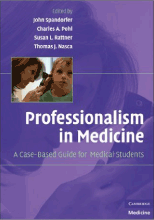
|
|
Spandorfer J, Pohl C, Nasca T, Rattner SL, eds. Professionalism in Medicine : A Case-Based Guide for Medical Students. Cambridge: Cambridge University Press; 2010.
|
| Thomas Jefferson University |
Video: Commitment to Improving Access to Care | Commentaries
A Faculty Perspective
Medical student-run clinics in homeless shelters are common throughout the United States. They provide hundreds of students with opportunities for valuable and substantive service-learning experiences that enhance their clinical training, augment team building and leadership skills, and foster their role as patient/societal advocates. The stories and problems of the homeless population are complex and reflect the growing divide between "those who have, and those who have not". (1) Homeless men and women have a significant burden of chronic disease, with increased morbidity and mortality, much of which is preventable and/or treatable. For a myriad of reasons, the "system" of care for the homeless is often the student-run shelter clinic, the emergency room and/or a hospital bed. Access to specialty services is limited, particularly for the uninsured or those with Medicaid.
The Medicaid program was created in 1965, in part to increase access of low income people to mainstream medical services. However, over the years, office-based physicians have reduced their treatment of Medicaid patients, and many have withdrawn from the program altogether (2). In addition, specialty physicians are much less likely than primary care physicians to accept new Medicaid managed care patients (3). The inadequacy of Medicaid payment rates, in comparison with those of Medicare and private insurance is often cited as a major factor contributing to low levels of Medicaid participation by physicians. (4) In fact, adverse selection may present serious financial risks for academic medical centers participating in Medicaid managed care. (5)
The question is…Can physicians refuse to accept patients who have Medicaid? Certainly they can. But should they refuse to accept Medicaid patients, particularly when these patients have been seen and evaluated by medical students from their institutions? Again, they can. But what message is this sending to the medical students, who rely on their faculty to model medical professionalism?
Medical educators are increasingly focusing on medical professionalism as a key element the curriculum. As Inui writes:
And how are we faring as medical educators in preparing future physicians for professional roles in our complicated world? I would conclude that the "formative arc" of education today is strong on the acquisition of technical knowledge and weak-to-negative on the acquisition of values and moral formation. While preparing successfully to pass tests of knowledge, our students measurably move from being open-minded and curious to test-driven and minimalistic, from open-hearted and idealistic to self-centered and well-defended, and from altruistic to cynical. In the course of their educational experience with us, they also move from taking notes and focusing on the explicit curriculum (what we say) to learning most from what we do. Here, then, is the greatest challenge of educating for professionalism. If we wish to change our students' preparation for their careers, we ourselves will need to change. (6)
Medical professionals and educators should look to Medical Professionalism in the New Millennium: A Physician Charter (7) as a guide to their work and actions. The preamble to this Charter is that professionalism is the basis of medicine's contract with society. Fundamental principles of professionalism are the primacy of patient welfare, patient autonomy, and social justice. "The medical profession must promote justice in the health care system, including the fair distribution of health care resources. Physicians should work actively to eliminate discrimination in healthcare, whether based on race, gender, socioeconomic status, ethnicity, religion, or any other social category." (7)
Specialists should follow the tenets of the above Charter and live by these precepts. They should resist efforts to impose a corporate mentality on a profession of service to others. (7) Students should not have to work in a system that models behavior which disregards the precepts of medical professionalism, and contributes to the erosion of their idealism and altruism. Instead, students should be afforded opportunities to be effective "community oriented primary care advocates." (8)
References:
- Plumb JD. Homelessness: Care, Prevention and Public Policy. Ann Internal Med 126; 15 June 1997:973-975.
- Davidson SM. Physician participation in Medicaid: background and issues. J Health Polit Policy Law. Winter 1982; 6(4): 703-
- Backus L, Osmond D, Grumbach K, Vranzian K, Phuong L, Bindman AB. Specialists and primary care physicians' participation in Medicaid managed care. J Gen Intern Med 2001;16:815-821
- Rowland D, Salganicoff A. Commentary: lessons from Medicaid – improving access to office-based physician care for low-income population. Am J Public Health 1994;84:550-552
- Bailey JE, Van Brunt DL, Mirvis DM, McDaniel A, Spears CR, Chang CF, Schaberg DR. Academic managed care organizations and adverse selection under Medicaid managed care in Tennessee. JAMA 1999; 282:1067-1072
- http://www.aamc.org/newsroom/reporter/sept03/viewpoint.htm, accessed August 11, 2007.
- Medical Professionalism in the New Millennium: A Physician Charter. Annals of Internal Medicine 2002;136: 243-246.
- Sandy LG, Schroeder SA. Primary care in a new era: disillusion and dissolution? Ann Intern Med 2003;138:262-267.
James Plumb, M.D., M.P.H.
Professor, Department of Family and Community Medicine
Jefferson Medical College